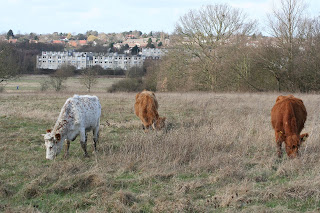On Saturday I went with my good freind Bexx for a walk beside the Lee Navigation where it flows close to her home in Seven Sisters in North-East London. It was a glorious summers afternoon, more remeniscent of June than March, and in walking by the river it became easy to forget that I was in London. Narrowboats use the Navigation, and many other people were using the opportunity to get some sunshine and get out on and near the water. We met a grey Heron sitting beside the Lee and he seemed happy to pose for a few photgraphs, even as cyclists and walkers passed by on the towpath, and a narrowboat passed by, it's happy occupants enjoying a pint in the sunshine.
We also saw several gulls flying about, making a commotion and diving at something in the river. It was never clear what it was, but Herring, Common and Lesser Black Backed gulls seemed keen on pursuing each other on the wing over it. The Common Gulls seemed few in number and largely immature, second summer, non-breeding birds. These are very much a wintering species in this part of the country and not generally part of the avifauna of summer here, although in the winter months adults and youngsters are one of the commonest species of "seagull" to be found on playing fields and other inland sites.
 |
| Young Common Gull diving for food in the Lee Navigation |
 |
| Upon emerging from the water the Common Gull was immediately ambushed by a larger Herring Gull |
We walked up as far as Tottenham Locks and a road bridge which reminded us that this waterside idyll was still in the bustling heart of London, and turned back toward Hackney where it was easy to forget. Allotments opposite Springfield park, a large area of manicured parkland with wonderful trees covered in blosson standing in it, had a Jay in them alongside some chaffinches, but by then the light had begun to fade and I was not able to get a good photograph. We stopped when we reached a pub, which sat opposide another open space, with read beds, and enjoyed a well-earned pint, as the last of the light faded.
Today I was unable to resist the opportunity to catch a little more sunshine and made my way up to Wat Tyler park in Essex. I sat on some wartime concrete beside the creek for an hour to begin with, but in the absence of birds contented myself with looking out across the network of creeks and saltmarsh toward industrial Canvey, and enjoying the heat, and the Small Tortoiseshell butterfly which was enjoying sunning itself on an exposed patch of earth on the sea wall. What struck me most about my trip was the number of butterflies which could be seen. The densities were still low but my list of butterflies for the day reached four species, Comma, Small Tortoiseshell, Peacock and Small White, the first of this species for the year. The heatwave had brought these out onto the wing. It certainly felt like summer.
Walking round the trails I saw few birds, plenty of Robins could be heard singing their hearts out, and blue and great tits alighted on the tops of bushes. Ever present was the tea-cher tea-cher call of Great Tits, one of the sounds of the springtime. I didn't see any waders here by the creeks from the estuary, but perhaps I timed my visit badly as the tide was high and the water glittered in the sunshine.
An hour in the main hide overlooking the scrape near the former National Powerboat Museum, now sadly closed down, probably revealed the best bird life, although there was still relatively little to see. A few Teal and Shoveller were all that remained of the once abundant wintering watefowl, an exodus among these species to more Northerly climes and their breeding season having clearly begun. I watched the Rookery on the other side of the marsh, as streams of the dark Corvids flew in from the estuary, and down from further inland, some of them with nesting material in the form of sticks, and pieces of litter, to add-to and repair their massive nests, the size and extent clearly revealed through the still leafless trees. A raptor, a small, smart male Sparrowhawk, put up some of the birds as it flew away from the Corvid colony, where presumably mobbing would have become dangerous, and I saw a couple of Lapwings remaining on the wetland, taking off on their big, white wings, their shape and underwing patterns unmistakable.
I made my way home by bicycle along the footpath of the A127, a tiring experience indeed. Riding down the 127 is not so much long and difficult, although it is long and the traffic fumes begin to make themselves known after a while, but it is boring. A long straight road.
A breif note before I go to mention the remarkable Great Spotted Woodpecker I have seen in my garden of late. He seems to have developed an elongated and slightly decurved beak. One wonders what effect this would likely have on his day to day activities but he seemed perfectly happy on our bird cake feeder. Interesting. We've also had goldfinches through recently making garden birding all the more interesting. I might have to send a copy of this photo off to the BTO to make enquiries but see what you make of it:


































